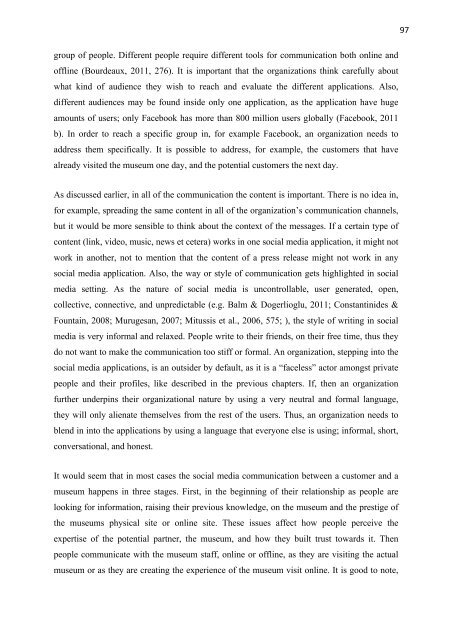Is there more to it than posting a status update?
Is there more to it than posting a status update?
Is there more to it than posting a status update?
You also want an ePaper? Increase the reach of your titles
YUMPU automatically turns print PDFs into web optimized ePapers that Google loves.
group of people. Different people require different <strong>to</strong>ols for communication both online and<br />
offline (Bourdeaux, 2011, 276). It is important that the organizations think carefully about<br />
what kind of audience they wish <strong>to</strong> reach and evaluate the different applications. Also,<br />
different audiences may be found inside only one application, as the application have huge<br />
amounts of users; only Facebook has <strong>more</strong> <strong>than</strong> 800 million users globally (Facebook, 2011<br />
b). In order <strong>to</strong> reach a specific group in, for example Facebook, an organization needs <strong>to</strong><br />
address them specifically. It is possible <strong>to</strong> address, for example, the cus<strong>to</strong>mers that have<br />
already vis<strong>it</strong>ed the museum one day, and the potential cus<strong>to</strong>mers the next day.<br />
As discussed earlier, in all of the communication the content is important. There is no idea in,<br />
for example, spreading the same content in all of the organization’s communication channels,<br />
but <strong>it</strong> would be <strong>more</strong> sensible <strong>to</strong> think about the context of the messages. If a certain type of<br />
content (link, video, music, news et cetera) works in one social media application, <strong>it</strong> might not<br />
work in another, not <strong>to</strong> mention that the content of a press release might not work in any<br />
social media application. Also, the way or style of communication gets highlighted in social<br />
media setting. As the nature of social media is uncontrollable, user generated, open,<br />
collective, connective, and unpredictable (e.g. Balm & Dogerlioglu, 2011; Constantinides &<br />
Fountain, 2008; Murugesan, 2007; M<strong>it</strong>ussis et al., 2006, 575; ), the style of wr<strong>it</strong>ing in social<br />
media is very informal and relaxed. People wr<strong>it</strong>e <strong>to</strong> their friends, on their free time, thus they<br />
do not want <strong>to</strong> make the communication <strong>to</strong>o stiff or formal. An organization, stepping in<strong>to</strong> the<br />
social media applications, is an outsider by default, as <strong>it</strong> is a “faceless” ac<strong>to</strong>r amongst private<br />
people and their profiles, like described in the previous chapters. If, then an organization<br />
further underpins their organizational nature by using a very neutral and formal language,<br />
they will only alienate themselves from the rest of the users. Thus, an organization needs <strong>to</strong><br />
blend in in<strong>to</strong> the applications by using a language that everyone else is using; informal, short,<br />
conversational, and honest.<br />
It would seem that in most cases the social media communication between a cus<strong>to</strong>mer and a<br />
museum happens in three stages. First, in the beginning of their relationship as people are<br />
looking for information, raising their previous knowledge, on the museum and the prestige of<br />
the museums physical s<strong>it</strong>e or online s<strong>it</strong>e. These issues affect how people perceive the<br />
expertise of the potential partner, the museum, and how they built trust <strong>to</strong>wards <strong>it</strong>. Then<br />
people communicate w<strong>it</strong>h the museum staff, online or offline, as they are vis<strong>it</strong>ing the actual<br />
museum or as they are creating the experience of the museum vis<strong>it</strong> online. It is good <strong>to</strong> note,<br />
97















